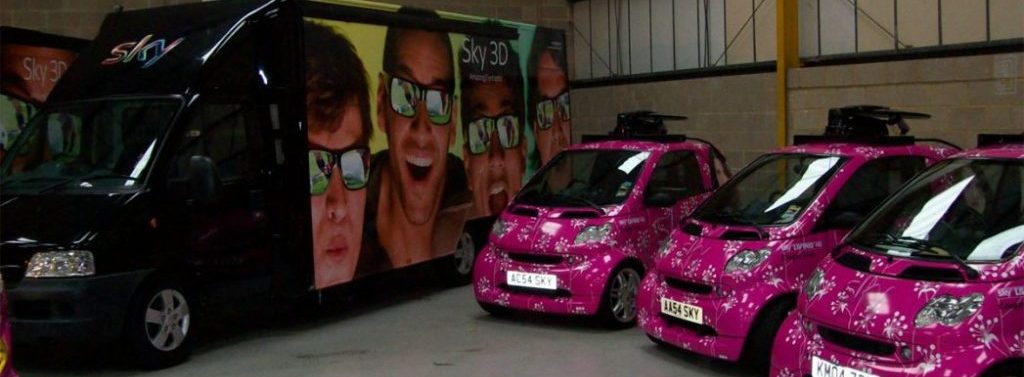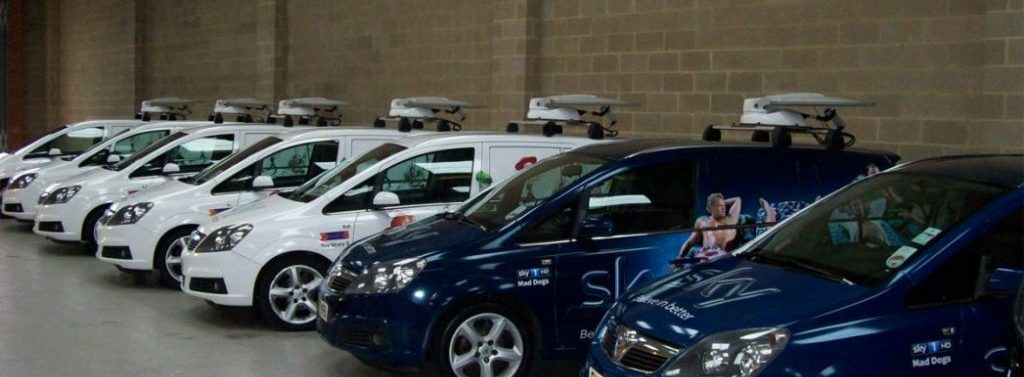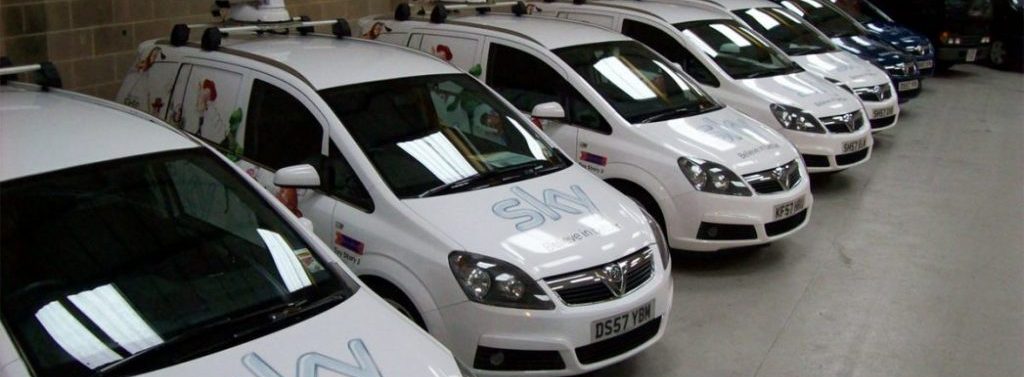Behind the Scenes of a Major Fleet Rebrand: How 25 Sky Vehicles Got a New Look
In recent years, designer Justin Murray has worked with some of the UK’s most respected companies and organisations, contributing to projects that span from high-end advertising to environmental campaigns. His portfolio includes collaborations with BBH (Bartle Bogle Hegarty), the legendary ad agency; Marvel, the global entertainment powerhouse; Greenpeace, the world’s leading environmental NGO; and broadcasting giant BSkyB (Sky).
Each project came with its own set of challenges—different industries, different goals, and different creative expectations. Yet Murray’s ability to adapt and deliver high-quality, visually compelling design has made him a trusted partner for clients who expect nothing less than perfection.
Among these many assignments, one particular project stood out: the large-scale fleet rebranding of 25 Sky sales and promotional vehicles. What began as a technical task of vehicle wrapping turned into a carefully choreographed operation that combined design, technology, logistics, and marketing.
This is the story of how it all came together.
The Brief: A Complete Vehicle Rebrand
In late 2010, Sky’s TV production and marketing division launched a new assignment: to rewrap their fleet of promotional and sales vehicles. These vehicles, which included Vauxhall Zafiras, Smart cars, and mobile exhibition trucks, travelled across the UK to support Sky’s sales campaigns and promotional events.
The objective was straightforward yet ambitious: remove the outdated vinyl wraps, install new branding, and ensure that each vehicle was in top condition—both inside and out—before returning to active service.
The scale was significant. Twenty-five vehicles would need to pass through the installation facility over a two-month period, each requiring removal, redesign, printing, application, and final delivery.
Every stage of the process demanded precision.
Step One: Delivery and Inspection
Each vehicle was delivered to the installation centre by third-party drivers. Upon arrival, the process began with a formal check-in at reception. Every vehicle was logged, photographed, and scheduled into the workflow.
But this wasn’t just about appearances. The vehicles also contained complex audiovisual equipment—from satellite dishes to HD televisions—that needed careful inspection.
This part of the process fell to Ken Priddy, founder of Ken Priddy Sound, Lighting, Communication, and his dedicated crew. Based in a hangar adjacent to the wrapping facility, Ken’s team conducted detailed checks, carried out repairs, and ensured that all the high-tech kit inside each vehicle was working flawlessly. Their role was vital: there was no point in a beautifully wrapped vehicle if the equipment inside failed during demonstrations or live broadcasts.
Step Two: Vinyl Wrap Removal
Once the internal checks were complete, each vehicle was moved into the vinyl installation area.
Here, the painstaking process of vinyl wrap removal began. Vehicle wraps cover every curve and contour, and after years of service, removing the old graphics was no quick task. The adhesive had to be carefully released without damaging the paintwork or body panels beneath.
It was labour -intensive work, but necessary. A clean surface was essential for the new vinyl to adhere properly and last the expected duration. Once stripped, the vehicles were thoroughly washed to eliminate any remaining residue before moving on to the next phase.
Step Three: Design and Adjustment
The new designs had already been provided by Sky’s creative team. However, no two vehicles are identical, and applying a flat graphic to a three-dimensional surface always requires adjustment.
This is where the graphic designers came in. Their job was to review, analyse, and—if necessary—revise the supplied artwork. They ensured that the visuals matched the specific dimensions and proportions of each vehicle. By refining the layouts digitally, they significantly reduced the risk of wasted vinyl during printing and installation.
This stage was crucial. Even a small misalignment could distort a logo or ruin the flow of a large image once applied to the curves of a car. Careful planning at the design stage made for smoother installation later.
Step Four: Printing the Vinyl
With the designs approved, the project moved to the print production plant.
Using a HP5000 inkjet printer, the team produced the graphics on Avery 1900 cast vinyl—a high-quality material known for both its durability and smooth finish. Although marketed as suitable for short-term wraps, its reliability and visual quality made it the perfect choice for this project.
The prints were rich, vibrant, and ready to transform the fleet into mobile billboards.
Step Five: Installation
Now came the most visible part of the project: the vinyl application.
Trained installers carefully positioned, stretched, and smoothed the vinyl over each vehicle’s body. This was precision work—every curve, corner, and edge had to be perfectly aligned. Large vehicles like the mobile exhibition trucks demanded extra time and expertise to ensure the graphics looked seamless from every angle.
Once applied, the wrap was trimmed and sealed. The installers double-checked for air bubbles or imperfections, making adjustments where necessary to achieve a flawless finish.
The result? A fleet that looked brand new, clad in fresh, professional Sky branding.
Step Six: Valeting and Quality Control
But the process didn’t end with wrapping. Each completed vehicle was returned to the hangar for a full valet service. Clean interiors, polished exteriors, and spotless windows were part of the finishing touches.
Before leaving the facility, every vehicle went through a final quality inspection. This included:
Checking the integrity of the vinyl wrap.
Testing the functionality of audiovisual equipment.
Ensuring vehicle logbooks were updated.
Signing off by project supervisors.
Only once these steps were complete were the vehicles cleared for collection.
Step Seven: Return to Sky
Gradually, third-party drivers returned to the centre to collect the finished vehicles. Each handover was carefully documented: keys signed out, paperwork checked, and the newly wrapped cars and trucks released back into Sky’s service.
However, not all vehicles left immediately. A number of them were held back for an additional purpose.
Filming on Location
Sky had arranged to use the facility for filming their latest training video. With the entire fleet freshly wrapped and visually striking, it was the perfect backdrop for internal communication material.
Over several days, a production crew shot footage on-site, showcasing the vehicles in action and documenting the transformation. This added another layer of value to the project: not only were the vehicles upgraded, but the process itself became part of Sky’s internal storytelling.
Once filming was complete, the remaining vehicles were signed out and dispatched, officially bringing the project to its conclusion.
The Bigger Picture: Why Vehicle Branding Matters
While this was a technical operation, it was also a marketing milestone. For Sky, these vehicles weren’t just modes of transport—they were mobile marketing platforms.
Branded fleet vehicles serve several purposes:
Visibility: Every journey puts the brand in front of thousands of potential customers.
Consistency: Vehicles carry the same message across different regions, reinforcing brand identity.
Professionalism: A well-maintained, well-branded fleet projects competence and credibility.
Flexibility: Vinyl wraps can be updated as campaigns change, ensuring messaging stays current.
By investing in a complete rebrand, Sky ensured that their fleet remained a dynamic, attention-grabbing part of their marketing strategy.
Reflections on the Project
Looking back, the Sky fleet rebrand was a complex but rewarding project.
For Justin Murray and the design team, it was an opportunity to translate creative concepts into real-world applications.
For Ken Priddy and his crew, it was a chance to integrate technical maintenance with a high-profile marketing assignment.
For the installation team, it was a showcase of precision and craftsmanship.
For Sky, it was a demonstration of brand commitment and attention to detail.
What made it truly remarkable was the collaboration: multiple teams, each with a distinct role, working seamlessly toward one shared goal.
The rebranding of Sky’s fleet in 2010 wasn’t just about swapping one vinyl wrap for another. It was about orchestrating a multi-phase operation—from inspection and removal to design, printing, installation, and final delivery.
It highlighted the importance of planning, precision, and teamwork in achieving large-scale branding goals. And most importantly, it reinforced the idea that vehicles are more than just transport—they’re moving canvases, carrying a company’s message directly into the public eye.
For Justin Murray, it was another successful chapter in a career defined by creativity and collaboration with some of the world’s most influential brands. For Sky, it was a refreshed fleet ready to drive their message across the UK.
A decade later, the story remains a perfect case study of how design, technology, and marketing intersect to deliver not just vehicles—but visibility, professionalism, and brand impact on the move.



